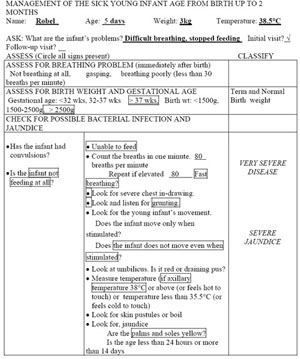Self-Assessment Questions (SAQs) for Study Session 3
Now that you have completed this study session, you can assess how well you have achieved its Learning Outcomes by answering these questions. Write your answers in your Study Diary and discuss them with your Tutor at the next Study Support Meeting. You can check your answers with the Notes on the Self-Assessment Questions at the end of this Module.
You will recall reading about Shashie in Activity 3.1 in this study session. We have reproduced the facts of her case here and you can also look back to Case Study 3.1 in this study session to remind yourself where the information about Shashie was entered on her recording form.
Read the Case Study 3.3 below and then answer the questions that follow.
Case Study 3.3 for SAQ 3.1
Shashie is five weeks old. Her weight is 4 kg and her axillary temperature is 37°C. Her mother has brought her to the clinic because she has a rash. You assess her for signs of possible bacterial infection. Shashie’s mother says that the baby has not had any convulsions. Her breathing rate is 55 per minute; she has no chest in-drawing and is not grunting. Her umbilicus is normal. You examine her entire body and find a red rash with just a few skin pustules on her buttocks. Shashie is awake, and her movements are normal. She does not have diarrhoea.
SAQ 3.1 (tests Learning Outcomes 3.1, 3.2, 3.6, and 3.7)
- a.How would you classify Shashie’s illness and how would you treat her?
- b.What advice would you give to the mother about how she should treat Shashie at home?
- c.When should Shashie return for a follow-up visit?
Answer
- a.You should have classified Shashie as having a local bacterial infection that can be treated by giving her antibiotics. You should have noted that Shashie also needs treatment at home for the pustules on her buttocks.
- b.Your advice to the mother would include telling her that it is always important to wash her hands when treating Shashie’s skin pustules. You would explain to her that she should treat Shashie twice a day and show her how to gently wash the pus and crusts with soap and water then dry the area before painting it with 0.5% gentian violet. Tell the mother that she should wash her hands again after giving this treatment to prevent spreading the infection to herself or anyone else she comes into contact with. You might also have remembered that you should tell the mother to breastfeed Shashie exclusively at least eight times in every 24 hours on demand and that it is important for her to keep Shashie warm. If the weather is cool, the mother can keep her young infant warm by covering her head and feet and dressing her in extra clothing.
- c.The mother should return for a follow-up visit immediately if Shashie shows signs of feeding poorly, becomes sicker, develops a fever or feels cold to touch, develops fast breathing, difficult breathing, blood in stool, deepening of yellow colour of the skin, redness, swollen discharging eyes, redness, pus or foul odour around the cord. Otherwise, she should return for a follow-up visit two days after the initial one.
Read this Case Study 3.4 and then answer the questions below.
Case Study 3.4 for SAQ 3.2
Robel is a five-day old, full term newborn whose weight is 3 kg, axillary body temperature 38.5°C. He is attending the health post for an initial visit. When you ask the mother what the problem is, she tells you that her baby is breathing with difficulty and that he has stopped breastfeeding. When you ask her if he has had convulsions she answers no. When you examine Robel for possible bacterial infection, he is breathing 80 breaths in one minute. When you count again, his breathing rate is still 80 in one minute; in addition you can hear he is grunting. Robel does not move even when you stimulate him, and the palms of his hands and soles of his feet are yellow. There are no other signs of illness.
SAQ 3.2 (tests Learning Outcomes 3.1, 3.2, 3.3, 3.4 and 3.5)
- a.How would you classify Robel’s illness and what would you do next?
- b.Write a referral note for Robel which you will show to your clinical mentor for comment at your IMNCI practical skills training session.
Answer
- a.You should have classified Robel’s illness as possible serious bacterial infection or very severe disease and severe jaundice. He will need urgent hospital treatment. However, before sending Robel to the health centre or hospital there are life-saving actions that you would take (i.e. give Robel pre-referral oral Amoxicillin and Gentamycine injection as well as treat him to prevent low blood sugar). You would need to explain to the mother the need for referral and that her baby will receive better care at the health centre or hospital. You would also need to advise the mother how to keep her young infant warm on the way to hospital.
- b.Show Robel’s referral form to your clinical skills mentor.
Summary of Study Session 3

